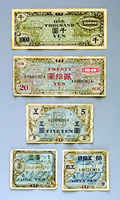Around October1945, permission was granted to move out of the internment camps and back into the villages and towns. But when residents returned to their villages, some found their land had been requisitioned as munitions or supply depots and they had no place to go.
The prewar system of municipalities and jurisdictions was revived, but it entailed starting from zero. Among the residents who were trying hard just to get food and supplies, the "fruits of war," black markets in stolen goods started forming and there were more than a few instances where persons stealing were shot at by U.S. troops.
In the middle part of 1946 there was still no currency available, so goods were bartered. There were several currency exchanges that occurred after this time but to prevent the inflation caused by the influx of Japanese yen, the military government introduced the B Yen currency, which provided a start for economic activities.
However, commodity prices, wages, and salaries were controlled so there were no free exchange transactions. This was when the black markets and smuggling goods became a major activity. In a life with so many restrictions, the residents of Okinawa constructed Sanshin (Okinawan samisen) from whatever was available, such as tin cans and string. They played and sang songs, prayed to their village gods, and tried to reconstruct Okinawa.

